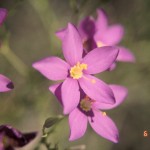Mountain Pink , Quinineweed
Centaurium beyrichii (Torr. & A. Gray ex Torr.) B.L. Rob.
Gentianaceae
Description
Texas is home to four species of Centaurium: C. beyrichii, Mountain Pink, the subject of this entry; C. texense, C. calycosum, and C. glanduliferum. All four species have attractive, small, pink flowers. Mountain Pink grows to about 1 foot or 20 cm tall with many branches and blossoms forming a rounded mass. Marshall Enquist in Wildflowers of the Texas Hill Country states Mountain Pink “usually grows in the shape of an inverted cone.” The narrow (3 mm), linear, leaves are simple, opposite each other on the stem, and attached directly to it. On the lower stem, the leaves are up to 3 cm grading into shorter, nearly threads on the upper stem. Pink to rose-colored flowers shaped like a five-pointed star are produced in late spring through summer. The flowers have five yellow anthers and a pale stigma that is kept away from the anthers by a bent style. The flower is up to 2 cm wide and has a floral tube up to 1.5 cm. The clasping calyx lobes are much shorter than the floral tube. It can provide nectar for moths, butterflies, and bees.Habitat
C. beyrichii is found in North Central to West Texas and into Arkansas. It usually grows in sunny areas on dry, rocky limestone hills or in seeps of granite. It is most common in the Edwards Plateau. Habitats include hillsides, prairies, plains, pasturelands, and savannahs.Toxic Agent
The toxic principle of the Centaurium spp. is unknown. The plant is suspected to be poisonous to cattle, sheep, and goats. Feeding Mountain Pink produced illness in five goats: of those, four died. One of the two sheep became ill. The toxic dose is estimated to be between 0.5 and 1 percent of the animal's body weight consumed daily for several days. The plant was suspected of causing the death of bighorn sheep in the Black Gap Wildlife Management Area in Brewster County.Signs of Livestock Ingestion
Affected animals exhibit: Loss of appetite; Signs of abdominal pain; Diarrhea. Examination after death may reveal damaged tissue containing blood in the liver and kidney, and severe ulcers and inflammation in the rumen and abomasum.Management Strategies
Mountain Pink is relatively unpalatable to grazing livestock. Good grazing management practices that improve range conditions can help reduce the consumption of the plant. Offer adequate mineral and nutritional supplements. Herbicides usually are unwarranted for minimizing toxicity problems from Mountain Pink.Images
Plant Characteristics
Flower Color: Pink
Seed Type: Non-Encapsulated
Duration: Annual, Biennial
Stem Texture: Hairless/Smooth
Growth Habit: Forbs/Broadleaf
Leaf Shape
 : Simple with Pinnate or Parallel Venation
: Simple with Pinnate or Parallel Venation
Season: Warm
Distribution
 : 04 - Blackland Prairies, 05 - Cross Timbers and Prairies, 07 - Edwards Plateau, 09 - High Plains, 10 - Trans-Pecos
: 04 - Blackland Prairies, 05 - Cross Timbers and Prairies, 07 - Edwards Plateau, 09 - High Plains, 10 - Trans-Pecos
Distributions
Distribution refers to the ecological region in Texas that a plant has been found. You can also view a clickable map.
Book: Toxic Plants of Texas (B-6105)
Collection: Toxics, Wild Flowers
Livestock Affected: Cattle, Goats, Sheep
Livestock Signs: Abdominal Pain, Anorexia, Colic, Diarrhea





